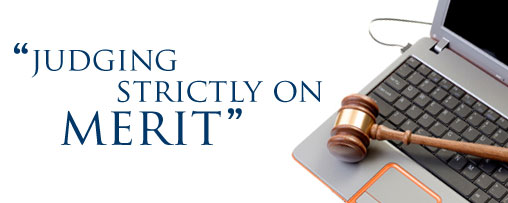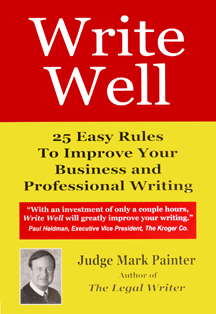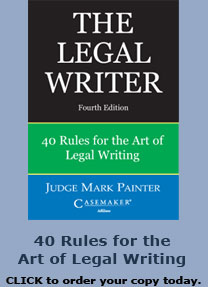Truth is always stranger than fiction
By Judge Mark P. Painter
|
In the allegedly rarefied – but actually rather stagnant – air of the appellate court, sometimes the day is unexpectedly enlivened. It was a few weeks ago by, of all things, a motion to strike a brief. Sitting there in a pile of other putatively dull motions, it didn’t cry out for immediate attention, even though our “motions meeting” was the next day. But I dutifully tackled it. This is the upshot: the real decision with the names changed for obvious reasons. Smithco, Inc. v. Insurers Painter, J. Not wishing to let stand a brief they consider too long, counsel for appellant Smithco, Inc., have moved this court to strike appellees’ (a group of insurance companies) joint brief. Smithco advances two arguments, contending the brief (1) put the citations in footnotes (where they belong!); and (2) uses footnotes to “get around” the page limit. And counsel even goes so far as to redraft their opponent’s brief, inserting the jumble of letters and numbers into the paragraphs – even the references to the record. Thus bollixed up and unreadable, the brief comes out to 38.5 pages, instead of the regulation 35. Egad. And Smithco makes some other objections to the form of the insurers’ brief, which we deem even more piddling. Our dreary day has been enlivened by the thought that lawyers care about one another’s prose so much as to redraft it. And that this dispute is so close that it may turn on a few extra pages of a lawyer’s argument. We can’t wait to read the final version – or maybe we should wait for the movie. As to citations, they belong in footnotes. Putting goofy letters and numbers in the middle of paragraphs destroys readability. We had to do that with typewriters, just as we had to use underlining because typewriters did not have italics. No more. But Smithco’s counsel makes one proper point: the insurers’ brief uses talking footnotes interspersed with citation footnotes. Using talking footnotes detracts from the gain in readability achieved by taking the citations out of the text – if footnotes are not for citations only, then the brief declines into law-reviewesque unreadability. The insurers respond to Smithco’s motion by stating that, at least on most points, Smithco is nitpicking or flat-out mistaken. They even cite the first edition of this author’s legal writing book (it is now in its third edition). And to clear up any possible problem, they have redrafted and resubmitted their brief – we now have three versions – shortening it somehow but not taking out the talking footnotes – having read only part of the cited treatise. We note, though, that the insurers still use 12-point type for the footnotes. We would approve 10-point, which would make their brief even shorter. We venture a guess that this court’s eventual opinion resolving this dispute will be fewer than 20 pages. To both sides we suggest that less is usually more. And because three judges of the appellate court have nothing better to do than referee a dispute about brief formatting, we hold as follows: (1) The insurers’ redrafted brief (the one they redrafted, not the one Smithco redrafted for them) is substituted for their original one, not because we would have done so in any event, but because it is slightly easier to read, though we wish they had retired the talking footnotes; (2) Were the reply brief not already filed, we would hold that counsel for Smithco, obviously having free time on their hands, should use some to whittle down their reply brief to 11 pages rather than 15, as they have wasted 4 pages on this motion. But the reply brief is 10 pages, so the penalty is perhaps self-imposed; and (3) Now that the pleadings are complete, perhaps the case can be decided on its merits. So ordered. GORMAN and SUNDERMANN, JJ., concur. ____________________________________ Mark Painter has served as a judge on the Ohio First District Court of Appeals for 11 years, after 13 years on the Hamilton County Municipal Court. Judge Painter is the author of The Legal Writer: 40 Rules for the Art of Legal Writing. It is available from http://books. lawyersweekly .com. Judge Painter has given dozens of seminars on legal writing. Contact him through his website, www.judge painter.org. |








